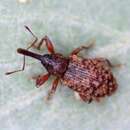en
names in breadcrumbs


Dorytomus taeniatus is a species of weevil native to Europe.[2][3] It was first described by Johann Christian Fabricius in 1781. The larvae cause a small growth (known as a gall) on the catkins of willows (Salix species).
Eggs are laid during the autumn in the axils of catkin buds and hatch the following spring.[4] The larvae cause an inconspicuous distortion of, usually, female catkins, thickening the rachis.[5] Catkins drop earlier than uninfected catkins and the larvae pupate in the soil.[6] Close examination of the gall is necessary as Redfern et al. (2011) note that sometimes, thickening of the rachis can be wound tissue rather than a gall and according to Plant Parasites of Europe identification is only possible by examining the weevils.[5][6]
The gall has been recorded from white willow (S. alba), eared willow (S. aurita'), goat willow (S. caprea), grey willow (S. cinerea) and purple willow (S.purpurea).[6]
Adults are 4–5 millimetres (0.16–0.20 in) long and brownish-black to black. They can be found from May onwards, browsing on the leaves, removing patches of tissue and exposing the network of fine veins.[4]
Found in western and central Europe including Great Britain (common) and Scandinavia.[7]
Dorytomus taeniatus is a species of weevil native to Europe. It was first described by Johann Christian Fabricius in 1781. The larvae cause a small growth (known as a gall) on the catkins of willows (Salix species).
Víðirani (fræðiheiti: Dorytomus taeniatus) er tegund af ranabjöllum (Curculionidae) ættuð frá Evrópu.[2][3] Henni var fyrst lýst af Johann Christian Fabricius 1781. Lirfurnar mynda smávægilegan vöxt (gall) á reklum víðitegunda.
Eggin eru lögð að hausti við rekilbrum og klekjast út næsta vor.[4] Lirfurnar mynda óverulega röskun á yfirleitt kvenreklunum.[5] Reklarnir falla fyrr en ósýktir og lirfurnar púpa sig í jarðvegi.[6] Nákvæm skoðun er nauðsynleg þar sem Redfern (et al. (2011)) bendir á að stundum geta komið svipaður útvöxtur vegna sára, og samkvæmt Plant Parasites of Europe er greining eingöngu möguleg með því að skoða bjöllurnar.[5][6]
Bjöllurnar eru 4 - 5 mm langar og brúnsvartar til svartar. Þær sjást frá maí, nartandi blöð.[4]
Hún finnst í vestur og mið Evrópu, þar á meðal Bretlandseyjum, Skandinavíu og Íslandi.[7] Á Íslandi er hann allstaðar á láglendi.[8]
Víðirani (fræðiheiti: Dorytomus taeniatus) er tegund af ranabjöllum (Curculionidae) ættuð frá Evrópu. Henni var fyrst lýst af Johann Christian Fabricius 1781. Lirfurnar mynda smávægilegan vöxt (gall) á reklum víðitegunda.